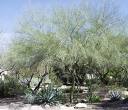Cercidium Floridum Tree Information
Images of Cercidium Floridum:






Cercidium Floridum grows in the following 4 states and provinces:
Arizona, California, Colorado, MaineInformation about Cercidium Floridum:
as well ashe Cercidium Floridum is commonly known as the Blue Paloverde.
The currently accepted scientific name of blue paloverde is Cercidium floridum Benth ex Gray. (Fabaceae) . Besides the typical subspecies that is recognized throughout most of the species range, C. f. ssp. peninsulare (Rose) Carter occurs in Baja California . Occasionally, blue paloverde hybridizes with yellow paloverde (C. microphyllum) .Blue paloverde is distributed through the Sonoran Desert. Its range extends from central and southwestern Arizona into southeastern California . Blue paloverde continues southward through western Sonora, Mexico . Disjunct populations of blue paloverde are located in northern Sinaloa and Baja California Sur .Blue paloverde is a characteristic member of the Sonoran Desert floristic region . It is a member of desert scrub communities. Blue paloverde is a major component in creosotebush (Larrea tridentata) and white bursage (Ambrosia dumosa) climax communities on lower bajadas . Blue paloverde is a facultative desert riparian species that may be restricted to washes or arroyos in parts of its range but also occurs in upland communities. It primarily occurs in communities irregularly scattered along arroyos . These communities with intermittent water are variously classified as desert riparian associations , pseudo-riparian communities , desert wash woodlands , Colorado River riparian forests , and desert microphyll associations . Codominants in all of these classifications are honey mesquite (Prosopis glandulosa var. glandulosa), smoketree (Psorothamnus spinosus), ironwood (Olneya tesota), desert willow (Chilopsis linearis), and catclaw acacia (Acacia greggii) . Blue paloverde is a dominant member of the mixed scrub series with ironwood and jojoba (Simmondsia chinensis) . Within the broadleaf woodland subformation, the paloverde series is dominated by either blue paloverde or yellow paloverde; the understory is sparse in this series . Blue paloverde is listed as a dominant or indicator species in the following publications: (1) A vegetation classification system applied to southern California (2) The vascular plant communities of California (3) Vegetation of the Santa Catalina Mountains, Arizona: a gradient analysis of the south slope . Species associated with blue paloverde but not previously mentioned in DISTRIBUTION AND OCCURRENCE include desert hackberry (Celtis pallida), desert lavender (Hyptis emoryi), big saltbrush (Atriplex lentiformis), Torrey seepweed (Suaeda torreyana), spidergrass (Aristida ternipes), and Rothrock grama (Bouteloua rothrockii) .Some of the information provided here is attributed to:Pavek, Diane S. 1994. Cercidium floridum. In: Fire Effects Information System, [Online]. U.S. Department of Agriculture, Forest Service, Rocky Mountain Research Station, Fire Sciences Laboratory (Producer). , available at the USDA Fire Effects Information System (FEIS) website